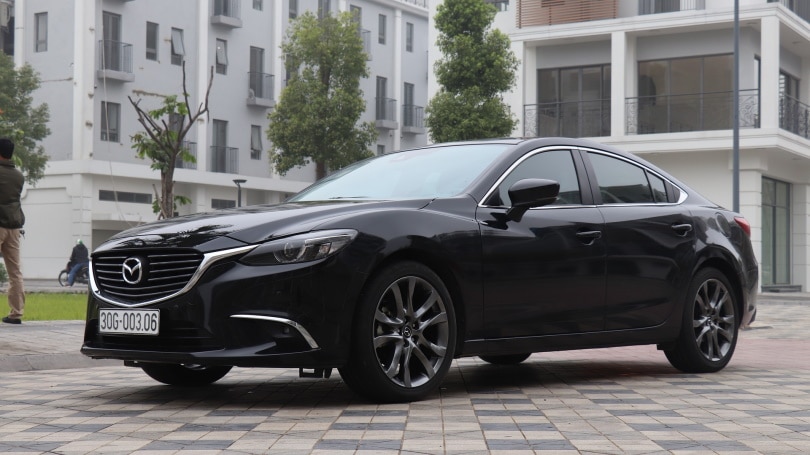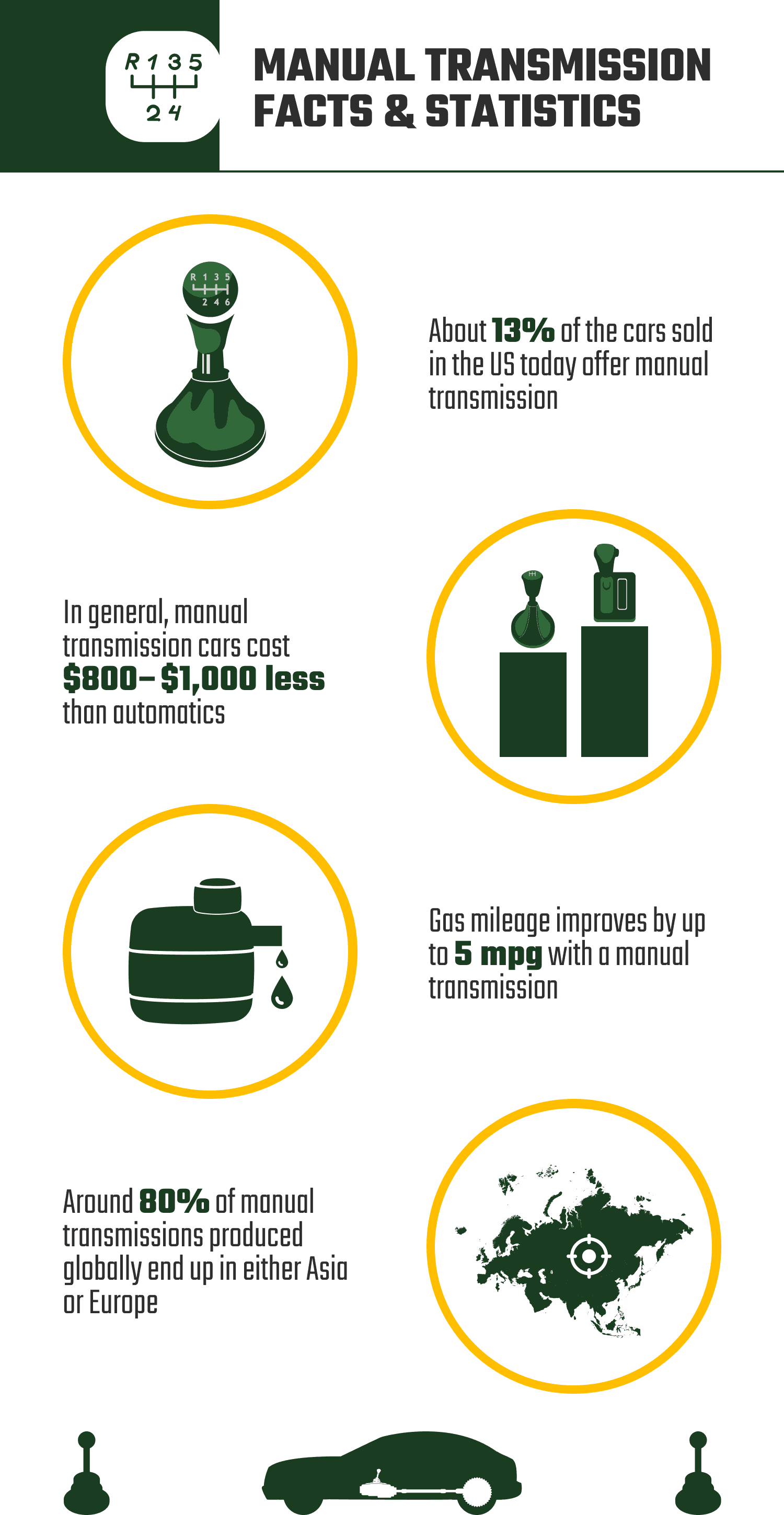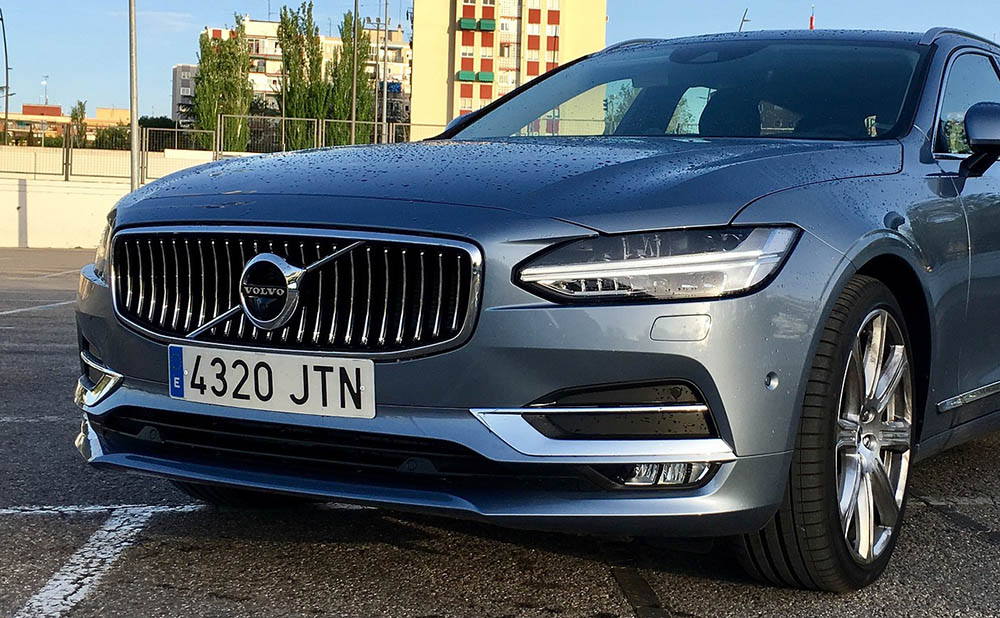8 Manual Transmission Statistics: 2025 Update
-

- Last updated:

Note: This article’s statistics come from third-party sources and do not represent the opinions of this website.
Did you know a car with manual transmission is also called a stick shift? And that’s because such vehicles are designed with a lever that literally resembles a stick. Its primary (and only) function is to allow the driver to accelerate or decelerate at will by manually changing gears.
We are, however, not going to talk about the different parts of a manual transmission. We could, but not today. Instead, we’ll be sharing some of the statistics that we think are too cool not to share with other car enthusiasts.
Click below to jump ahead:
 Top 8 Manual Transmission Statistics
Top 8 Manual Transmission Statistics
- About 13% of the cars sold in the US today offer manual transmission.
- Idaho has a 4.2% manual transmission purchase rate.
- Harrisonburg, VA has a 5.84% purchase rate.
- Manuals are $800–$1,000 cheaper than their automatic twins.
- A 10-year-old manual is more efficient than a 10-year old automatic.
- Gas mileage improves by two to five mpg with a manual transmission.
- 80% of manuals produced globally end up in either Asia or Europe.
- 66% of drivers know how to operate a stick shift.

What’s the Market Saying About Sales?
1. About 13% of the cars sold in the US today offer a manual transmission.
(CNBC)
And this is a significant drop from the 37% recorded more than a decade ago. You know, we would be lying if we stood here and told you guys that we have no idea why the manual transmission market is dying off. We do, and the answer lies in the technological advancements in the automobile industry.
Back in the day, automatic transmissions lagged in several departments. They never offered better torque control, acceleration, or even additional gear choices. You only had three gears to work with, as opposed to manual transmissions, which offered up to six gears.
But all that has changed, thanks to technology. Automatic transmission manufactures have now found a way to improve their previous sup-par reliability, sluggish performance, and questionable-control vehicles.
Convenience and comfort are the other threats to the manual transmission markets. Most people trying to learn how to drive often find automatic transmissions easier to understand, and a lot more comfortable.

2. Idaho has a 4.20% manual transmission purchase rate.
(Carmax)
If you’re thinking of opening a car dealership that only sells manual transmission, go start your business in Idaho. According to Carmax surveys, more people are buying shift levers in that state than they are anywhere else in the country. But if it’s an autobox dealership, move to Illinois. The people there are less likely to invest in a stick shift.
3. Harrisonburg, VA has a 5.84% purchase rate.
(Carmax)
Manuals are more popular in Harrisonburg city, than they are in any other city. When some of the residents were asked why they think that is, they said most drivers prefer cars that are more engaging. Something that won’t automatically change to the next gear, just because you’ve increased or decreased your acceleration. But it seems like residents of Oak Lawn, IL have a different preference because they were listed as the city with the least purchase rate.

Affordability, Comfort, and Efficiency
4. Manuals are $800–$1,000 cheaper than their automatic twins.
(moneyunder30)
Of course, this is expected, seeing as their markets are on a downward trajectory. Different American dealerships are constantly looking for ways to entice willing customers and offering incredibly low discounts is one of those ways.
However, that’s not the only reason why manuals are more affordable in comparison to their automatic counterparts. If you’ve ever driven an automatic before, you’ll know these vehicles are more software than hardware. And by that we mean, they’ve been designed to rely more on the computers, than the mechanics. So typically, they have more parts than manual transmissions, which are 100% nuts, bolts, and rods.
More parts equate to more cost of production, which in turn equate to higher prices. Remember that equation.
5. A 10-year old manual is more efficient than a 10-year old automatic.
(moneyunder30)
There are two ways of looking at this. We can look at it from the cost perspective or from the operational perspective. If we decide to take the cost perspective route, then we’ll have to look at the cost of repairing a manual transmission problem in relation to that of an automatic.
Because manuals are all mechanics, you only must figure out which component needs replacing or fixing. And they are always so flexible, in that sometimes you could use the spare part of a different car if it works.
But with the automatic, you first have to make sure the component that needs replacing matches the software installed in that particular vehicle. So, you could find the exact component, but not be able to use it because your software is a downgrade from what the market currently offers.
Operationally, you’ll also be facing the same problem. A software update might render your car less efficient compared to its manual twin.

6. Gas mileage improves by 2 to 5 mpg with a manual transmission.
(Consumer Reports)
It’s all physics: the harder you work, the more energy you consume. Drivers who prefer driving cars with the gear level have reported a significant increase in their fuel economy. And experts say this could be because vehicles with manual transmission are more efficient when it comes to shifting between gears. Their motors don’t work as hard as those of automatic, thus saving on fuel.
But that’s not to say that all manuals have better gas mileage. You still must factor in the model and make of car. We have cars that are everything except fuel efficient, even though they have manual transmissions. So just make sure you do your due diligence before buying, instead of assuming.
7. 80% of manuals produced globally end up in either Asia or Europe.
(DriversEd)
Most countries look at automatic transmission as luxuries meant for those who belong in the higher echelons of society. They believe most Americans can afford an automatic because the country enjoys a much more developed status.
There’s also the other debate that we’ve talked about, which is fuel consumption. Since they aren’t fuel efficient, and the fuel prices in Europe are exorbitantly high, people tend to steer clear of them.
That being said, we’ve seen the demand for automatic transmission in these countries slightly improve over the past couple of years, as technology helps to alleviate the fuel consumption problem.
The Asian and European topography has certainly contributed to the high demand for manuals outside the US. You see, some of the things that define these continents are the bumpy terrains, hilly regions, busy cities, and narrower roads. Driving through such places requires the ultimate experience that only the manual transmission can provide.
Lastly, we have the policy factor. In some countries, for example the United Kingdom, you can only be given a license to become a driver if you know how to handle the manual transmission. It’s actually the reason why all their driving schools have cars designed with manual transmission.

8. 66% of drivers know how to operate a stick shift.
(The Harris Poll)
And this is clearly not a small population. In addition, 55% admitted they’ve owned or rented a manual at some point in their lives, and 27% still have a strong preference for manual transmission.
The report also revealed something else—we learned that most of the people who leased or owned manual cars were 55 years or older. But this wasn’t surprising at all considering humans usually stick with things that they are most comfortable with. Manuals came first, so the older generations got used to them.
Frequently Asked Questions About Manual Transmissions
Are manual transmissions dying?
(MotorBiscuit)
Yes, unfortunately, the manual transmission is experiencing a case of “multimorbidity”. That refers to a situation where something’s dying because of not one, but multiple factors. We wouldn’t want to camp here all day repeating the same things that we’ve already talked about, so we’ll add something different. And that is… mainstream media.
Unintentionally, the media industry has been selling this narrative that manual transmissions are reserved for sports cars. And this is incredible marketing if “petrolheads” were the target audience. But for someone looking to make a quick school or grocery run, it’s definitely a turnoff.
Do manuals get into more accidents?
To be honest, we don’t have reliable or adequate data to draw conclusions at this moment. What we can however say is, in comparison to the autobox, the manual will always ask for some degree of skill. And if the driver is somewhat skilled, the odds of being involved in an accident are drastically reduced.
But like we’ve said, it’s all speculation at this point.

Is driving a manual worth it?
If you’ve been given a choice, we’d encourage you to learn how to drive a manual transmission before you try out the autobox. Not that we have a preference or anything, but all you’re required to do with an automatic transmission is to put the car in ‘D’ (drive) and that’s it. Once you’ve done that, the vehicle’s system will take over and change the gears for you.
Manual transmissions have five gears. And whichever gear you choose to use will depend on your terrain and acceleration. These are things that you won’t be able to learn, unless you have an experienced driver by your side.
And yes, the learning process will be harder. There’s no denying that.
Is it more difficult to steal a manual car?
This is another question that cannot be answered because there’s no real data describing the rate at which manually equipped vehicles are being stolen. Tracking such thefts is just next to impossible. And don’t be fooled by what you see in these blockbuster movies. Hot-wiring a car is not as simple as they make it seem. Heck, even getting through those doors is an uphill task.
 Conclusion
Conclusion
Long story short, if you decide to purchase a manual, you’ll save a ton of cash in the process. And we’re not just talking about the short-term period, but long-term as well. Think about the lifetime repair and maintenance costs, in addition to the total money used to gas it, and tell us if that math doesn’t add up.
Featured Image Credit: Pixabay
Contents
 Top 8 Manual Transmission Statistics
Top 8 Manual Transmission Statistics
